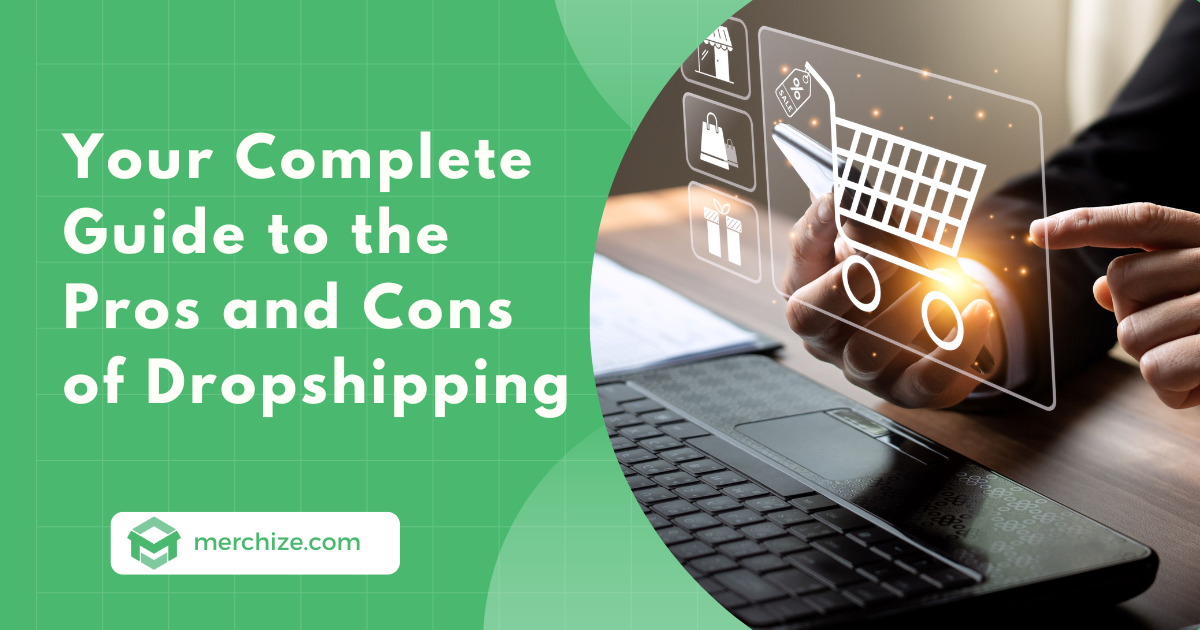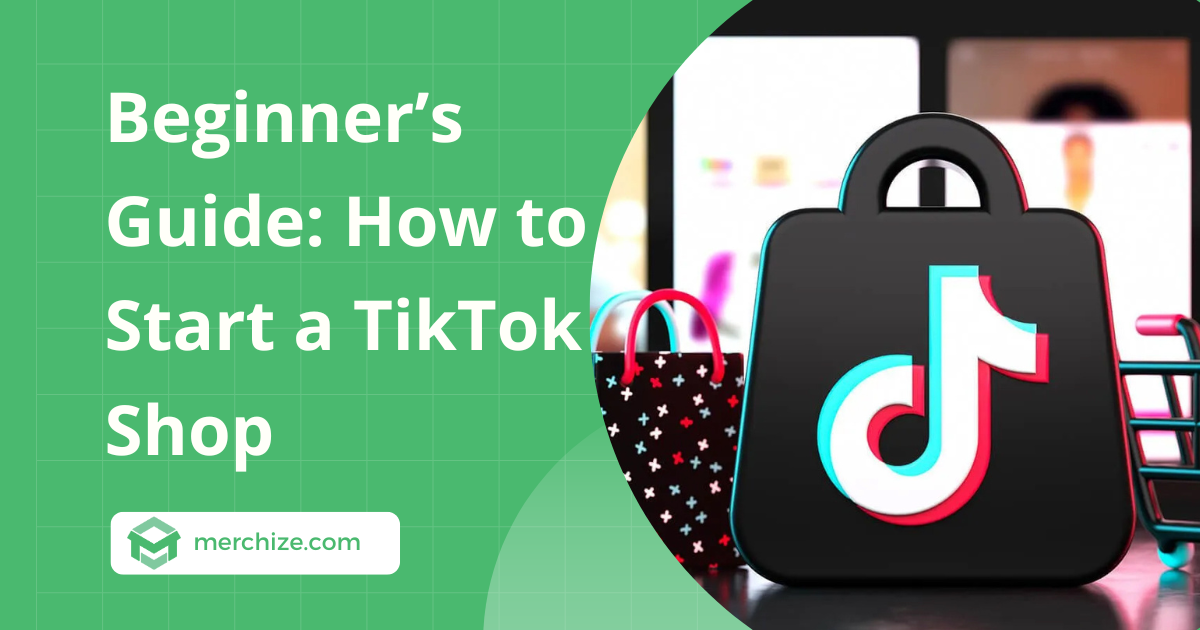Contents
Have you ever heard of the term dropshipping but do you really understand what it is in detail? In fact, this business model is becoming more and more popular, with unlimited potential. Let’s explore what it is, pros and cons of dropshipping, and how to start a successful dropshipping business in 2025.
What is dropshipping?
Dropshipping is a business model where sellers operate their online store without handling inventory, warehousing, packaging, or shipping. These tasks are taken care of by the supplier. The seller’s primary role is to implement marketing strategies and attract buyers.
Here’s how this business model works:
- The seller signs up with a product supplier, which can be based anywhere around the world.
- When a customer places an order on the online store, the order details (including the product information, price, and customer’s address) will be automatically transferred to the supplier’s system.
- The supplier then produces, packs and delivers the package directly to the customer, based on the order information.
- When the order is complete, the revenue recorded in the system will be transferred to the seller and the supplier based on an agreement between both parties.
You might also be interested in: Dropshipping vs Wholesale: What Are the Differences and Which to Choose?
Pros and cons of dropshipping
Pros
The dropshipping business model offers several outstanding advantages, such as:
- No warehouse management: When doing Dropshipping business, you don’t need to handle inventory, imports, or transportation. These tasks are taken care of by the supplier, allowing you to focus solely on finding suppliers, building sales channels, and marketing.
- Low start-up costs: Unlike traditional businesses, Dropshipping is an e-commerce business model that doesn’t require upfront inventory investments. Your initial costs are primarily for building sales channels, marketing, and advertising.
- Low risk: Since you don’t need to purchase inventory upfront, you won’t lose money on unsold products or tied-up capital.
- Flexibility: As dropshipping is an online business, you can operate your store from anytime, at anywhere. The only things required are a laptop/tablet, and a strong internet connection.
- Diverse product options: Dropshipping allows you to sell any products that align with your research and passion.
Cons
Despite its advantages, dropshipping also has some potential drawbacks:
- Supplier dependence: As the supplier handles the delivery and logistic work, you’ll heavily rely on their performance for shipping, inventory management, and product quality. It means that any supply issues that arise can significantly impact your business.
- High competition: As there are no capital required and low investment costs, dropshipping is easy to enter, but it’s also an extremely fierce market. So without unique products or selling strategies, it can be challenging to stand out from numerous sellers.
- Risk of product exclusivity: As dropshipping becomes more popular, product exclusivity may be short-lived, making it harder to differentiate your business and increasing the risk of failure.
While dropshipping presents exciting opportunities, it’s crucial to carefully consider both the pros and cons before starting this business model.
Common mistakes for new dropshipping sellers
Mistake #1: Assuming dropshipping is very simple
Many people often mistakenly believe that dropshipping is a simple and easy business to pursue. In fact, this opinion is extremely misguided. Dropshipping is a fiercely competitive industry, and to generate a sustainable revenue stream, you need to conduct thorough market and product research, possess astute business acumen, and invest in effective advertising strategies.
Without these crucial elements, your efforts may become pointless. Therefore, if you really want to run a successful dropshipping business, it is essential to approach it with seriousness, dedication, and willingness to learn and improve continuously.
Mistake #2: Neglecting market or product research
Failure to research the market and products will cause you to choose outdated, inappropriate or poor quality products, which will greatly affect your business. Because if your product does not bring value to customers, it will be difficult to build a loyal customer base and obtain new customers.
Mistake #3: Selling too many product types
A common mistake in dropshipping is offering a wide variety of products in an attempt to cater multiple customer preferences. However, this approach can strike back as it forces you to divide your focus across many products and customer segments, making it difficult to provide a tailored experience to any one group.
Instead, you should focus on 1 or a certain group of products. Then research the market, products, and potential customers to come up with the most effective marketing strategies and plans.
Mistake #4: Selecting only one supplier
When starting a dropshipping business, don’t rely on just one supplier. That leaves you vulnerable if issues arise with that single supplier. Instead, you need backup plans and a variety of supplier options to properly evaluate products and services.Specifically:
- Build relationships with multiple suppliers concurrently, rather than relying on just one.
- Evaluate the quality of products and services from each supplier over an extended period, then retain the top performers.
- Pay close attention to customer feedback and experiences. Use those insights to provide constructive suggestions that can help suppliers enhance their service and boost sales for your online store.


Mistake #5: Ignoring customers’ reviews and feedback
While the dropshipping business model eliminates the need to manage inventory, shipping, or product quality, you still need to pay close attention to customers’ reviews and feedback as these feedbacks can directly affect your store’s performance. At the same time, you can optimize your products, processes, or customer experience based on the feedback, which will ultimately improve your service.
Mistake #6: Not developing a specific plan
Any business type, including dropshipping, requires a well-defined plan. This plan includes market research, product selection, supplier selection, marketing, advertising, and more. Having a specific plan in place right from the start will help you determine your goals and stay on track. Moreover, a solid plan will help you optimize your profits more effectively.
FAQs
Is dropshipping profitable in 2025?
The potential of dropshipping has been proven by multiple reports from reputable sources, including:
- According to a report by Grand View Research, the global dropshipping market size was valued at $162.44 billion in 2022 and is expected to grow at a compound annual growth rate (CAGR) of 28.8% from 2023 to 2030.
- Another report by Technavio states that the dropshipping market is expected to grow by $57.91 billion during 2021-2025, at a CAGR of 28.41%. The report cites the increasing popularity of e-commerce platforms and the growing demand for on-demand delivery as key drivers of this growth.
- A survey conducted by Oberlo in 2021 found that 37% of dropshippers make a profit margin of 20% or more, with 23% of them earning profit margins between 20-30%. The same survey revealed that 22% of dropshippers earn annual revenue of $1,000 to $10,000, while 16% earn $10,000 to $50,000 annually.
These data and reports indicate that the dropshipping market has significant potential for growth, driven by factors such as the rise of e-commerce, on-demand delivery services, and the availability of suppliers and manufacturers, particularly in the Asia-Pacific region.
What is the difference between dropshipping and print on demand?
Dropshipping and Print-on-Demand (POD) are both eCommerce business models that allow you to sell without holding inventory upfront or shipping products yourself. However, they differ in several key areas:
| Aspect | Dropshipping | Print-on-Demand (POD) |
| Product sourcing | Pre-made products from various suppliers | Custom-printed products made to order |
| Inventory | No inventory required upfront | No inventory required upfront |
| Product customization | Limited customization options | High level of product customization |
| Supplier relationships | Work with multiple suppliers | Typically partner with specialized POD suppliers |
| Profit margins | Often slim due to high competition | Higher margins for unique, customized products |
| Target market | Broader market appeal | Niche-focused, personalization seekers |
| Order fulfillment | Supplier handles shipping to customer | POD supplier prints, packages, and ships order |
What are the most popular platforms for dropshipping?
As a new seller, it may be difficult to find the best platform for your dropshipping business. But don’t worry – we’ve got you covered! Here is a list of some popular dropshipping platforms and a brief introduction to help you make a decision.
| Platform | Description | Key Statistics |
| Oberlo | Oberlo is a popular dropshipping app that integrates with Shopify. It allows merchants to import products from various suppliers directly into their Shopify store. | – Over 1 million active merchants
– Connects to suppliers with over 67 million products |
| AliExpress | AliExpress is a popular online retail service owned by Alibaba Group. It connects dropshippers with suppliers in China and other countries. | – Over 100 million products listed
– Has over 200 million buyers worldwide |
| Salehoo | Salehoo is a directory of verified dropship suppliers and wholesale companies. It provides access to over 8,000 suppliers across various product categories. | – Over 137,000 members
– Offers access to 2.5 million products |
| Spocket | Spocket is a dropshipping platform that curates products from various suppliers across the US, Europe, and Asia. It integrates with popular e-commerce platforms. | – Over 60,000 merchants
– Offers over 25 million products |
| Modalyst | Modalyst is a European-based dropshipping platform that provides access to suppliers in Europe and the US. It integrates with several e-commerce platforms. | – Over 40 million products listed
– Serves merchants in over 190 countries |
| Dropified | Dropified is an AI-powered dropshipping platform that helps automate various aspects of the business, including product research and order fulfillment. | – Over 250,000 merchants
– Integrated with 20+ suppliers |
The bottom line
Now that you have a clear understanding of the pros and cons of dropshipping, you can make an informed decision about starting this business model in 2025. Dropshipping offers a lucrative opportunity worth considering, but it’s crucial to go into it with your eyes wide open. Just remember that with the right mindset, preparation, and execution, success is well within your grasp!






